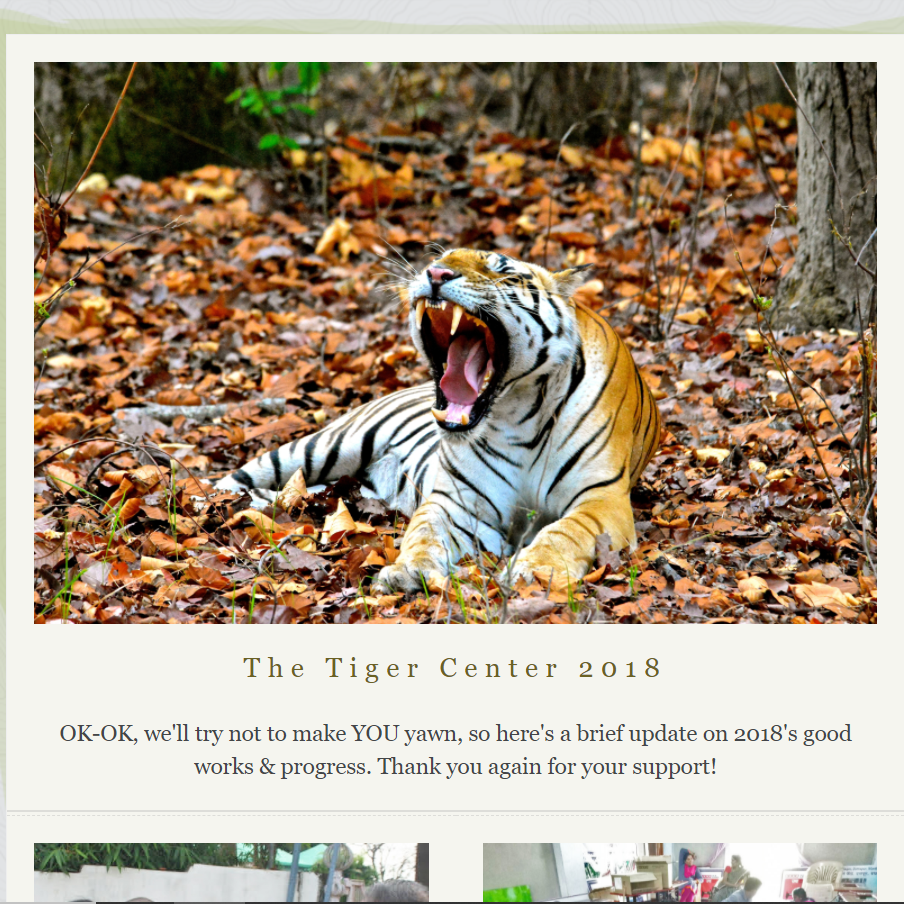





The Tiger Center
WILDLIFE & ENVIRONMENT NPO OF THE YEAR – INDIA (2025)
AND
SOCIAL ENTERPRISE INNOVATOR OF THE YEAR - INDIA (2023)
* * *
TIGERS
Once over 100,000 of these beautiful cats roamed the earth.
Now 6,000 remain.
Come see why they're worth saving
and what they mean to their environment and us.
Below: Male Hard-Ground Barasinga, ONLY found in Kanha.
The Tiger Center
WILDLIFE & ENVIRONMENT NPO OF THE YEAR – INDIA (2025)
AND
SOCIAL ENTERPRISE INNOVATOR OF THE YEAR - INDIA (2023)
* * *
TIGERS
Once over 100,000 of these beautiful cats roamed the earth.
Now 6,000 remain.
Come see why they're worth saving
and what they mean to their environment and us.
Below: Male Hard-Ground Barasinga, ONLY found in Kanha.

Environment
Not only is the tiger worth saving from extinction, but he's a wonderful spokesman for the environment and the people who live with him.
Our mission: Help the Tiger ◦ Help the Environment ◦ Help the People
Environment
Not only is the tiger worth saving from extinction, but he's a wonderful spokesman for the environment and the people who live with him.
Our mission: Help the Tiger ◦ Help the Environment ◦ Help the People

People
Why all 3 - Tigers, Environment, and People?
When we interviewed Nature Reserve authorities asking what we could do for the tiger, they said help the tiger's environment and help the people who live there. If the environment is thriving, the tiger will thrive. If the people are better off, they will take care of the environment, avoid poaching animals and plants from the forest, and resist helping tiger poachers.
To help tigers, environment, or people ... you must help them all.
In fact, some of our initiatives directly impact more than one element of our mission statement. In our Usha Tiger Center Silai Sewing School, for example, women in our community learn valuable job skills and earn certification as independent tailors, many of whom open their own businesses. The school is 100% solar-powered and equipped with water filters -- the first such renewable-energy and eco-friendly facility in our region. Usha now encourages their 26,000 schools across 17,000 villages to do the same.
People
Why all 3 - Tigers, Environment, and People?
When we interviewed Nature Reserve authorities asking what we could do for the tiger, they said help the tiger's environment and help the people who live there. If the environment is thriving, the tiger will thrive. If the people are better off, they will take care of the environment, avoid poaching animals and plants from the forest, and resist helping tiger poachers.
To help tigers, environment, or people ... you must help them all.
In fact, some of our initiatives directly impact more than one element of our mission statement. In our Usha Tiger Center Silai Sewing School, for example, women in our community learn valuable job skills and earn certification as independent tailors, many of whom open their own businesses. The school is 100% solar-powered and equipped with water filters -- the first such renewable-energy and eco-friendly facility in our region. Usha now encourages their 26,000 schools across 17,000 villages to do the same.

Photography
To raise funds and raise awareness, we've published three photography books (available on Amazon) and share our images on Facebook.
Come ... surf our site to see what we do, contact us if you'd like to contribute, buy a book or download our Facebook photos, and spread the word about these beautiful animals, our environment to protect, and the people who strive to thrive along with them.
Photography
To raise funds and raise awareness, we've published three photography books (available on Amazon) and share our images on Facebook.
Come ... surf our site to see what we do, contact us if you'd like to contribute, buy a book or download our Facebook photos, and spread the word about these beautiful animals, our environment to protect, and the people who strive to thrive along with them.

What We Do
Tigers - Our whitepapers on conservation and economic development have been discussed in the Parliament of India and impacted public policy.
Environment - We promote eco-technologies by using them for our operations and distributing them to those in need.
People - We provide essential services to our community they associate with the tiger (through us), many of which also reduce human-animal and human-environment conflict (e.g. beekeeping, snake relocation from homes to forest, and income opportunities outside the forest).
What We Do
Tigers - Our whitepapers on conservation and economic development have been discussed in the Parliament of India and impacted public policy.
Environment - We promote eco-technologies by using them for our operations and distributing them to those in need.
People - We provide essential services to our community they associate with the tiger (through us), many of which also reduce human-animal and human-environment conflict (e.g. beekeeping, snake relocation from homes to forest, and income opportunities outside the forest).
To date, our impact includes the following:
o Green-economic advice to India’s Supreme Court for infrastructure decisions, new development model discussed in India’s Parliament, and public policy impact in a variety of areas
o 9.5 million impressions on the Acquisition International website (139,000+ web users) — the organization that awarded us “Wildlife & Environment NPO of the Year - India” and “Social Enterprise Innovator of the Year - India”. These awards help raise awareness worldwide of the need to help endangered wildlife, the environment, and the disadvantaged people who live with and protect them
o 2.5 million schoolchildren influenced with our conservation messages (plus, of course, parents via the kids)
o 26,000+ schools in nearly 16,000 villages being encouraged by Usha International to do as we’ve done in our women’s-empowerment Usha Sewing school – run on clean (solar) energy and use water filters
o 25,000 recipients of our blankets, clothing, household goods, and water filters
o 6,600 patient-visits provided through medical camps
o 150+ women empowered through sewing certification, enabling micro-loans and new tailoring businesses
o Income initiatives for people earning USD 2/day yet facing 60 - 70% unemployment, including indigenous art and dance performances, micro-entrepreneurship from beekeeping, and furniture building from forest waste
o International art & culture initiatives that have raised awareness of the environment and indigenous people
o Book on The Tiger Center, book chapter, articles, videos, news interviews, and other media engagement that raises awareness nationally and internationally of the need to help endangered species, environment, and people (including business) thrive together
To see our annual Year In Review reports, just click below:
To start receiving regular updates, just:













